|
Overcoming Dud Sessions |
|
|
|
Some people may not feel any response to Shakti at first, and may want to know how to get it to work for them.
First of all, if you are having 'dud' sessions, you can do them a bit more often. One-hour sessions should be done every 21 days (unless there are other instructions for the session design, as with two-phase sessions). If you are having 'duds', you can do them once a week. You should never do sessions more often than once in 72 hours, no matter what the outcome.
There been several people who began doing Shakti sessions without results and later were able to get their sessions going. In retrospect, a pattern emerges in looking at their experiences. What happened with each of them was that they had done at least six sessions on a regular schedule, followed by a three week break after which they began to do their sessions again. During the second group of sessions, they changed their signals. In these cases, that was when their sessions went from dud to dramatic.
What these people had in common was that first, they did their initial sessions with the same signal at the same volume. They did not try different signals with each session. Secondly they had each done six sessions, once a week without effect, and then in spite of their lack of effects, they went ahead and stopped doing sessions for three weeks. After that, they began again still continuing with the same signals as they had used in their first series of sessions. They all changed their signals.
One person had increased his volume. Another person from a stereo signal with the amygdala on the left and the hippocampus on the right to the same amygdaloid signal on the left and the alternative hippocampal signal on the right. Another changed his signal source from a CD player to his computer's sound card.
The simplest explanation, and one consistent with known neural mechanisms, is that the brain responds to all of the sessions, but that both the stimulus and response remained outside of conscious awareness. Further, the brain may have habituated to this stimulation. Later, when the signal changed the habituation was no longer effective in obscuring the stimulation. And that was why the effects emerged when they did. Accommodation, habituation, and the alteration of the stimulus to which the individual had become habituated in the first place.
Let's imagine a metaphor. You move into new home in the middle of summer. You have a next-door neighbor who has a fan in the window of their house in a place where you can't see it. It's never turned off. The sound is continually in the background, and it's not loud, so you never hear it. One day, the fan is turned off. Then, the fan is turned on again. Now, you hear it. A sound that your brain learned to ignore completely now stands out quite prominently. Thereafter, you would be able to hear the sound (and to note that it's still there) just by listening for it.
Let's be clear. This is only a metaphor. The actual mechanisms have nothing to do with sound or your ears.
If you're having dud sessions you may be tempted to try many different signals looking for one that will make things happen for you. This would not be the pattern appearing with those people whose sessions became successful after a dud beginning.
If you want to try something different with each session, and you find you're off to a slow start, a more productive approach will be to apply the same signal in the same intensity to different parts of your brain.In another case, a man who had no response to several session designs did five sessions over the temporal lobes using the amygdaloid and hippocampal signals in sequence followed by a sixth session over the frontal lobes. One day later he had an episode of bliss.
Shakti can require patience. These individuals stayed on their session schedule without deviating from it, in spite of their lack of response. They demonstrate the sober attitude with which Shakti should be used.
Their caution and adherence to procedure are examples for every Shakti user.
They also suggest another approach to overcoming 'dud' sessions that's been incorporated in to this version of the software.Small differences in the signals can create big differences in effectiveness, especially if the user has done a few dud sessions. Their brains will have habituated to the signals, so the sessions aren't creating any changes in the state of consciousness.
One of the ways a signal can be changed without changing it's speed or amplitudes is to change the frequencies. In other words, change the 'equalization'. The Shakti signal generator has presets that adjust the frequencies, just like your stereo might have settings for "pop", "rock", or "classical". If you do a few sessions without effect, your brain may have just absorbed the signal, without being influenced by it.
The Equalizer
But there is a limit to the number of times a brain can "ignore" a signal (no one knows how many exactly) if that signal changes. Variations make the signals 'novel', so the brain takes note of them again. To change your signals in this way, you should change your equalizer 'preset'.
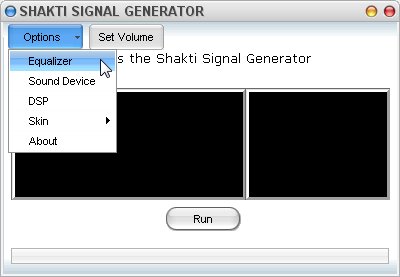

There are a few equalizer presets you can choose, and there is no way of knowing which one is most likely to get things moving for you, but the default setting (Shakti) was prepared by Stan Koren, the inventor of the very first version of this class of technology. The rest are there to allow further change to the signals, increasing your chances for injecting novelty into your sessions - Giving your brain a message it can't ignore.
Click on OPTIONS to access the equalizer.
You can adjust the equalizer yourself to enhance specific bands, but it's suggested you make changes to existing equalizer setting to enhance the bands you choose (there is no tech support for this - it's there to add more options for those who are already experienced with mind machines, and understand their principles. If you don't know which bands you want to enhance, then just use the existing settings).
NOTE ABOUT THE SETTINGS:
1) If you used Shakti For Windows before Version 5, and you had good results, you might like to choose old_shakti. This is close to the suggested settings for previous versions.
2) The setting simply called "Shakti" is the default setting, and this is the one prepared by Stan Koren, the inventor of the "Koren Helmet", seen on so many TV documentaries. It was prepared by comparing the signals (as produced by the laboratory solenoids) to Shakti Signals (as produced by the Shakti Coils). The equalizer setting reflects the difference between the two types of coils, as well as their frequency response. The Shakti Coils are so much better at producing the very low frequencies that, to match Shakti's output to the original lab output, the lower bands had to be reduced. It speaks very well of the Shakti coils.
3) The settings that include the word "Bass" in their names are a bit 'louder' in the lower frequencies, raising the level for many of the frequencies in the hippocampal signals, the 'Random Theta Noise' signal, the 40 hertz signals, and some others.
4) The square wave settings exist because the raw output consists of complex, irregular square waves, which are 'flattened' into sinusoidal waves by the coils, both in the lab, and in Shakti.
DSP PluginsDSP stands for "Digital Signal Processing". This is a way of adding effects to audio in real-time. The Shakti Signal Generator has two DSP "Plugins". These make very fine adjustments to the volume level. One of them, the "randomizer" raises and lowers the volume at random every few milliseconds (you can change how much and how often). The "fractalizer" steps the volume up and down in small (or large) steps, so the volume changes constantly. It also changes the size of these steps each time one happens. This makes it even harder for the brain to 'habituate' to the signals. Changing the signals in this way will make it harder for the brain to get used to the signals, and 'tune them out".
NOTE:
These kinds of adjustments to the signals are not possible with the original laboratory equipment, and so they have not been studied in laboratory settings. This means that the ideal settings are not yet known.
However, to maintian the integrity of the signals, the time frame should be kept between 130 and 260 milliseconds, as most of the signals are about 260 milliseconds, and so there is not much point in ln longer periods than that. Making the times shorter than 130 milliseconds may change the signals to the point where the brain no longer recognizes them as 'speaking it's own language'.
An analysis of the laboratory output showed variations of up to 52%, so the lowest setting for the volume variation should be 48%, though other settings might also be effective. Start with the default settings. If you do not know what settings to use, it's best to make small changes when adjusting the settings. The "law of noticible differences", developed to express how much brighter or fainter a light has to be for the eye to notice the difference, tells us that 2% is enough. There is no such law for neural magnetic fields, but this law of vision shows that the brain couls easily respond to small differences in field strength. So, the
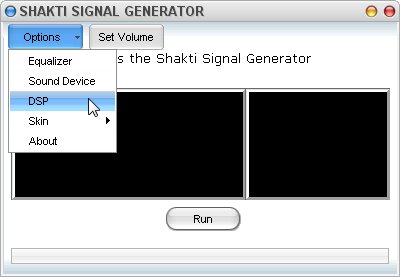
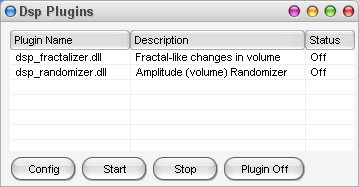
There are two DSP plugins for the Shakti Signal Generator.
1) The Fractalizer and 2) the Randomizer. The Randomizer is the best one to start with. By default, they are both OFF.
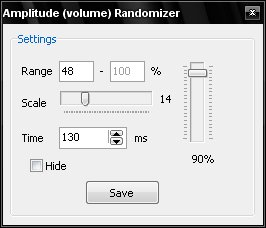
This is the 'config' panel for the Randomizer plugin.
It has several variables.
Range - This shows the range for the changes in the overall volume. In this example, the lowest volume is 48% of the overall volume. The range of volume changes never goes over 52%.
Scale - This shows (and controls) how much the volume will change each time the plugin alters the volume.
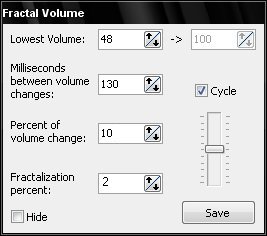
This is the 'config' panel for the Fractalizer Plugin.
It has several variables
Lowest Volume - This limits the lowest volume setting. In this example, the lowest volume is 48% of the overall volume. The range of volume changes never goes over 52%.
Percent of Volume Change - this tells the plugin to raise and lower the volume in steps of 10%
Fractalization percent - This changes the Percent of Volume Change by a small percent (the picture shows 2%) each time the volume is changed.
Cycle - This tells the plugin to first lower the volume, and then to raise it again. If this box is not selected, the plugin will lower the volume, and that begin the cycle from the top of the overall volume again.
IMPORTANT QUESTIONHow many 'dud' sessions should you let pass before changing the equalizer setting or using the DSP plugins?
Do one series of six sessions. Take the 21 day break. Begin another series of sessions. If you still have 'dud' sessions after three more, change your equalizer settings, and continue on, finishing the second series of six on schedule.
If you still have dud sessions after this, email for tech support. At that point, it might be a good idea to look at changing your sound card.